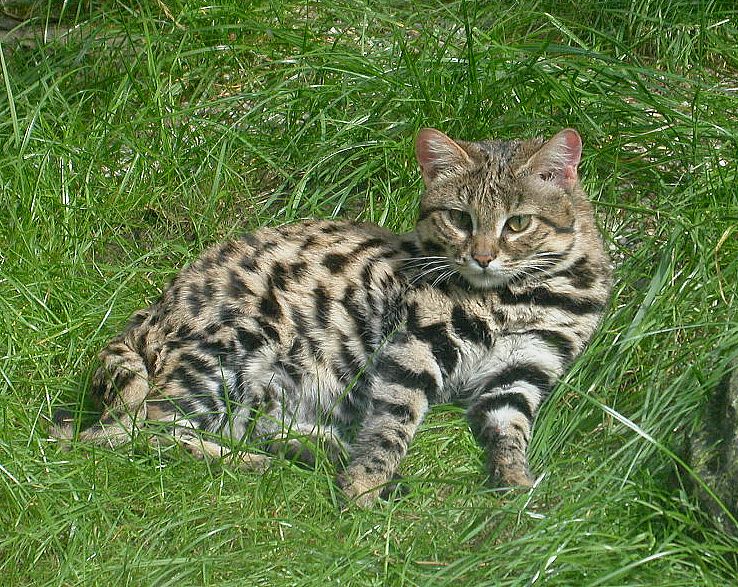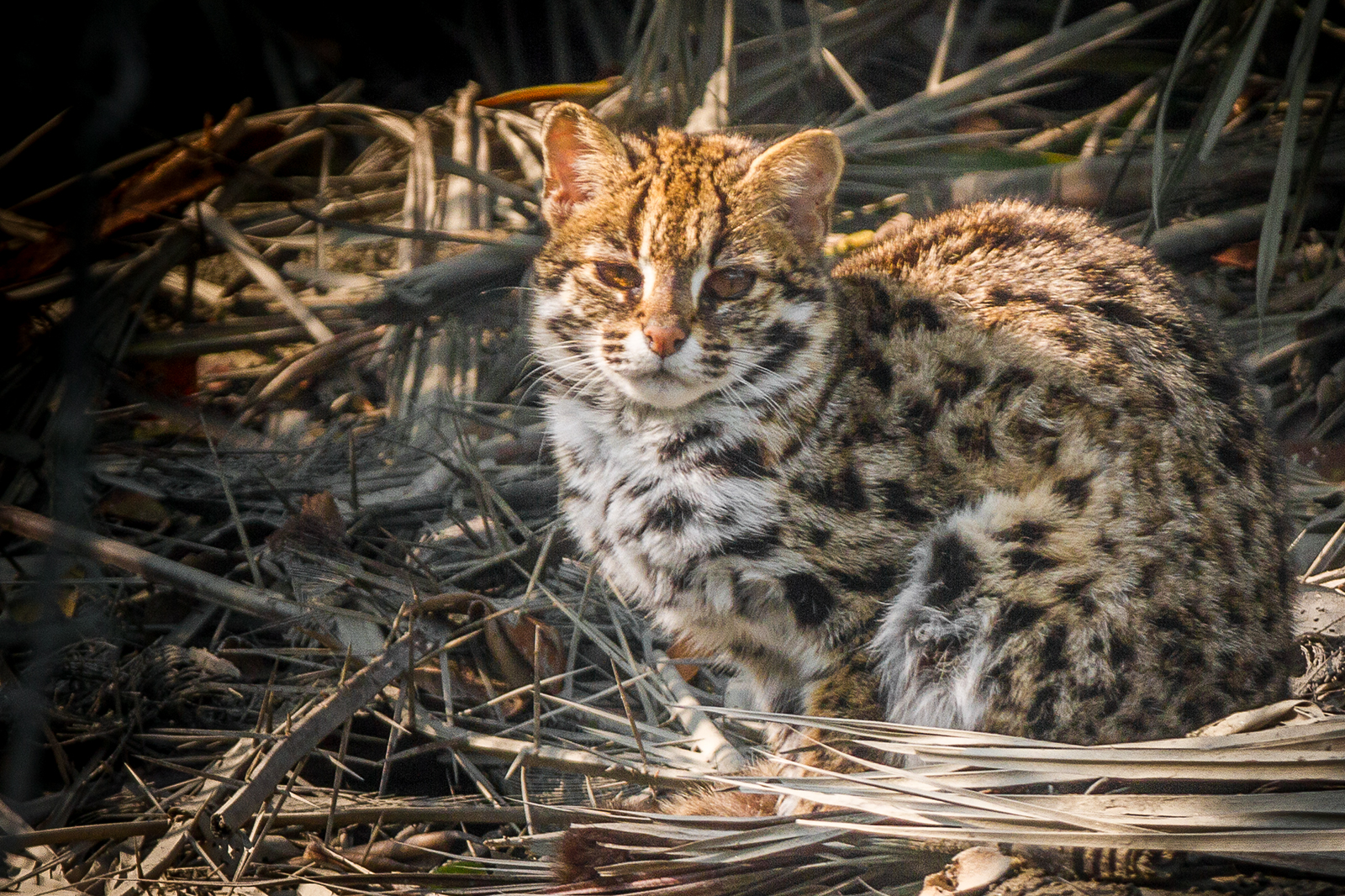|
Felis
''Felis'' is a genus of small and medium-sized cat species native to most of Africa and south of 60° latitude in Europe and Asia to Indochina. The genus includes the domestic cat. The smallest ''Felis'' species is the black-footed cat with a head and body length from . The largest is the jungle cat with a head and body length from . Genetic studies indicate that the Felinae genera ''Felis'', '' Otocolobus'' and ''Prionailurus'' diverged from a Eurasian progenitor of the Felidae about 6.2 million years ago, and that ''Felis'' species split off 3.04 to 0.99 million years ago. Etymology The generic name ''Felis'' is derived from Classical Latin ''fēlis'' meaning "cat, ferret". Taxonomy Carl Linnaeus considered ''Felis'' to comprise all cat species known until 1758. Later taxonomists split the cat family into different genera. In 1917, the British zoologist Reginald Innes Pocock revised the genus ''Felis'' as comprising only the ones listed in the following table. Estimated gene ... [...More Info...] [...Related Items...] OR: [Wikipedia] [Google] [Baidu] |
Sand Cat
The sand cat (''Felis margarita'') is a small wild cat that inhabits sandy and stony deserts far from water sources. With its sandy to light grey fur, it is well camouflaged in a desert environment. Its head-and-body length ranges from with a long tail. Its short ears are set low on the sides of the head, aiding detection of prey moving underground. The long hair covering the soles of its paws insulates its pads against the extremely hot and cold temperatures in deserts. The first sand cat known to science was discovered in the Algerian Sahara and described in 1858. To date, it has been recorded in several disjunct locations in Western Sahara, Morocco, Algeria, Niger, Chad, Egypt, the Arabian Peninsula and the Middle East. In Central Asia, it was first recorded in the Karakum Desert in 1925. The large gap between these two regions of its global range was partially closed in 1948, when a sand cat skin was found in an oasis of the Rub' al Khali in Oman. It is discontinuously d ... [...More Info...] [...Related Items...] OR: [Wikipedia] [Google] [Baidu] |
Jungle Cat
The jungle cat (''Felis chaus''), also called reed cat, swamp cat and jungle lynx, is a medium-sized cat native to the Middle East, the Caucasus, South and Southeast Asia and southern China. It inhabits foremost wetlands like swamps, littoral and riparian areas with dense vegetation. It is listed as Least Concern on the IUCN Red List, and is mainly threatened by destruction of wetlands, trapping and poisoning. The jungle cat has a uniformly sandy, reddish-brown or grey fur without spots; melanistic and albino individuals are also known. It is solitary in nature, except during the mating season and mother-kitten families. Adults maintain territories by urine spraying and scent marking. Its preferred prey is small mammals and birds. It hunts by stalking its prey, followed by a sprint or a leap; the ears help in pinpointing the location of prey. Both sexes become sexually mature by the time they are one year old; females enter oestrus from January to March. Mating behaviour is ... [...More Info...] [...Related Items...] OR: [Wikipedia] [Google] [Baidu] |
European Wildcat
The European wildcat (''Felis silvestris'') is a small wildcat species native to continental Europe, Scotland, Turkey and the Caucasus. It inhabits forests from the Iberian Peninsula, Italy, Central and Eastern Europe to the Caucasus. Its fur is brownish to grey with stripes on the forehead and on the sides and has a bushy tail with a black tip. It reaches a head-to-body length of up to with a long tail, and weighs up to . In France and Italy, the European wildcat is predominantly nocturnal, but also active in the daytime when undisturbed by human activities. It preys foremost on small mammals such as lagomorphs and rodents, but also on ground-dwelling birds. Taxonomy ''Felis (catus) silvestris'' was the scientific name proposed in 1778 by Johann von Schreber when he described a wild cat based on texts from the early 18th century and before. In the 19th and 20th centuries, several wildcat type specimens were described and proposed as subspecies, including: * ''Felis silvest ... [...More Info...] [...Related Items...] OR: [Wikipedia] [Google] [Baidu] |
Black-footed Cat
The black-footed cat (''Felis nigripes''), also called the small-spotted cat, is the smallest wild cat in Africa, having a head-and-body length of . Despite its name, only the soles of its feet are black or dark blackish brown. With its bold small spots and stripes on the tawny fur, it is well camouflaged, especially on moonlit nights. It bears black streaks running from the corners of the eyes along the cheeks, and its banded tail has a black tip. The first black-footed cat known to science was discovered in the northern Karoo of South Africa and described in 1824. It is endemic to the arid steppes and grassland savannas of Southern Africa. In the late 1960s, it was recorded in southern Botswana, but only few authentic records exist in Namibia, in southern Angola, and in southern Zimbabwe. Due to its restricted distribution, it has been listed as a vulnerable species on the IUCN Red List since 2002. The population is suspected to be declining due to poaching of prey species f ... [...More Info...] [...Related Items...] OR: [Wikipedia] [Google] [Baidu] |
Felinae
The Felinae are a subfamily of the family Felidae. This subfamily comprises the small cats having a bony hyoid, because of which they are able to purr but not roar. Other authors have proposed an alternative definition for this subfamily: as comprising only the living conical-toothed cat genera with two tribes, the Felini and Pantherini; thus excluding all fossil cat species. Characteristics The members of the Felinae have retractile claws that are protected by at least one cutaneous lobe. Their larynx is kept close to the base of the skull by an ossified hyoid. They can purr owing to the vocal folds being shorter than . The cheetah ''Acinonyx'' does not have cutaneous sheaths for guarding claws. Taxonomy The term 'Felini' was first used in 1817 by Gotthelf Fischer von Waldheim, at the time for all the cat species that had been proposed as belonging to the genus ''Felis''. In 1917, Reginald Innes Pocock also subordinated the following genera to the Felinae that had been propo ... [...More Info...] [...Related Items...] OR: [Wikipedia] [Google] [Baidu] |
African Wildcat
The African wildcat (''Felis lybica'') is a small wildcat species native to Africa, West and Central Asia up to Rajasthan in India and Xinjiang in China. It has been listed as Least Concern on the IUCN Red List in 2022. In Cyprus, an African wildcat was found in a burial site next to a human skeleton in the Pre-Pottery Neolithic B settlement Shillourokambos. The graves are estimated to have been established by Neolithic farmers about 9,500 years ago, and are the earliest known evidence for a close association between a cat and a human. Their proximity indicates that the cat may have been tamed or domesticated. Results of genetic research indicate that the African wildcat genetically diverged into three clades about 173,000 years ago, namely the Near Eastern wildcat, Southern African wildcat and Asiatic wildcat. African wildcats were first domesticated about 10,000 years ago in the Near East, and are the ancestors of the domestic cat (''F. catus''). Crossings between domestic ... [...More Info...] [...Related Items...] OR: [Wikipedia] [Google] [Baidu] |
Domestic Cat
The cat (''Felis catus'') is a domestic species of small carnivorous mammal. It is the only domesticated species in the family Felidae and is commonly referred to as the domestic cat or house cat to distinguish it from the wild members of the family. Cats are commonly kept as house pets but can also be farm cats or feral cats; the feral cat ranges freely and avoids human contact. Domestic cats are valued by humans for companionship and their ability to kill rodents. About 60 cat breeds are recognized by various cat registries. The cat is similar in anatomy to the other felid species: they have a strong flexible body, quick reflexes, sharp teeth, and retractable claws adapted to killing small prey. Their night vision and sense of smell are well developed. Cat communication includes vocalizations like meowing, purring, trilling, hissing, growling, and grunting as well as cat-specific body language. Although the cat is a social species, they are a solitary hunter. As ... [...More Info...] [...Related Items...] OR: [Wikipedia] [Google] [Baidu] |
Felis Catus
The cat (''Felis catus'') is a domestic species of small carnivorous mammal. It is the only domesticated species in the family Felidae and is commonly referred to as the domestic cat or house cat to distinguish it from the wild members of the family. Cats are commonly kept as house pets but can also be farm cats or feral cats; the feral cat ranges freely and avoids human contact. Domestic cats are valued by humans for companionship and their ability to kill rodents. About 60 cat breeds are recognized by various cat registries. The cat is similar in anatomy to the other felid species: they have a strong flexible body, quick reflexes, sharp teeth, and retractable claws adapted to killing small prey. Their night vision and sense of smell are well developed. Cat communication includes vocalizations like meowing, purring, trilling, hissing, growling, and grunting as well as cat-specific body language. Although the cat is a social species, they are a solitary hunter. As a pr ... [...More Info...] [...Related Items...] OR: [Wikipedia] [Google] [Baidu] |
Domestic Cat
The cat (''Felis catus'') is a domestic species of small carnivorous mammal. It is the only domesticated species in the family Felidae and is commonly referred to as the domestic cat or house cat to distinguish it from the wild members of the family. Cats are commonly kept as house pets but can also be farm cats or feral cats; the feral cat ranges freely and avoids human contact. Domestic cats are valued by humans for companionship and their ability to kill rodents. About 60 cat breeds are recognized by various cat registries. The cat is similar in anatomy to the other felid species: they have a strong flexible body, quick reflexes, sharp teeth, and retractable claws adapted to killing small prey. Their night vision and sense of smell are well developed. Cat communication includes vocalizations like meowing, purring, trilling, hissing, growling, and grunting as well as cat-specific body language. Although the cat is a social species, they are a solitary hunter. As ... [...More Info...] [...Related Items...] OR: [Wikipedia] [Google] [Baidu] |
Pallas's Cat
The Pallas's cat (''Otocolobus manul'', also known as the manul, is a small wild cat with long and dense light grey fur. Its rounded ears are set low on the sides of the head. Its head-and-body length ranges from with a long bushy tail. It is well camouflaged and adapted to the cold continental climate in its native range, which receives little rainfall and experiences a wide range of temperatures. The Pallas's cat's pupils are rounded, a unique feature among the Felinae. The Pallas's cat was first described in 1776 by Peter Simon Pallas, who observed it in the vicinity of Lake Baikal. In the early 19th century, it was reported to occur in Tibet, and in the Transcaspian Region in the early 20th century. To date, it has been recorded across a large areal extent, albeit in widely spaced sites in the Caucasus, Iranian Plateau, Hindu Kush, parts of the Himalayas, Tibetan Plateau, Altai-Sayan region and South Siberian Mountains. It inhabits rocky montane grasslands and shrublands, w ... [...More Info...] [...Related Items...] OR: [Wikipedia] [Google] [Baidu] |
Chinese Mountain Cat
The Chinese mountain cat (''Felis bieti''), also known as Chinese desert cat and Chinese steppe cat, is a small wild cat endemic to western China that has been listed as Vulnerable on the IUCN Red List since 2002, as the effective population size may be fewer than 10,000 mature breeding individuals. It was provisionally classified as a wildcat subspecies with the name ''F. silvestris bieti'' in 2007. It is recognised as a valid species since 2017, as it is morphologically distinct from wildcats. Taxonomy The scientific name ''Felis bieti'' was proposed by Alphonse Milne-Edwards in 1892 who described the Chinese mountain cat based on a skin collected in Sichuan Province. He named it ''Felis Bieti'' after the French missionary Félix Biet. Some authorities consider the ''chutuchta'' and ''vellerosa'' subspecies of the wildcat as Chinese mountain cat subspecies. Characteristics The Chinese mountain cat has sand-coloured fur with dark guard hairs. Faint dark horizontal stripes ... [...More Info...] [...Related Items...] OR: [Wikipedia] [Google] [Baidu] |
Prionailurus
''Prionailurus'' is a genus of spotted, small wild cats native to Asia. Forests are their preferred habitat; they feed on small mammals, reptiles and birds, and occasionally aquatic wildlife. Taxonomy ''Prionailurus'' was first proposed by the Russian explorer and naturalist Nikolai Severtzov in 1858 as a generic name for a single felid occurring in tropical Asia, namely ''Felis pardachrous'' described by Brian Houghton Hodgson — the leopard cat. As varieties, Severtzov lists ''Felis nipalensis'' described by Thomas Horsfield and Nicholas Aylward Vigors, ''Leopardus Elliotti'', ''Leopardus Horsfieldi'' and ''Leopardus chinensis'' described by John Edward Gray, and ''Felis bengalensis'' described by Anselme Gaëtan Desmarest. The British zoologist Reginald Innes Pocock recognized the taxonomic classification of ''Prionailurus'' in 1917. In 1939, he described the genus on the basis of skins and skulls, and compared these to body parts of ''Felis''. ''Prionailurus'' species ... [...More Info...] [...Related Items...] OR: [Wikipedia] [Google] [Baidu] |

.jpg)



_on_the_road.jpg)

.jpg)

